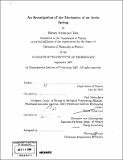| dc.contributor.advisor | Paul Matsudaira and Alexander van Oudenaarden. | en_US |
| dc.contributor.author | Tam, Barney Kwun-poo | en_US |
| dc.contributor.other | Massachusetts Institute of Technology. Dept. of Physics. | en_US |
| dc.date.accessioned | 2009-04-29T17:36:29Z | |
| dc.date.available | 2009-04-29T17:36:29Z | |
| dc.date.copyright | 2007 | en_US |
| dc.date.issued | 2007 | en_US |
| dc.identifier.uri | http://hdl.handle.net/1721.1/45402 | |
| dc.description | Thesis (Ph. D.)--Massachusetts Institute of Technology, Dept. of Physics, 2007. | en_US |
| dc.description | Includes bibliographical references (p. 81-89). | en_US |
| dc.description.abstract | To produce motion, cells rely on the conversion of potential energy into mechanical work. One such example is the dramatic process involving the acrosome reaction of Limulus sperm, whereby a 60-im long bundle of actin filaments straightens from a coiled conformation to extend out of the cell in five seconds. This cellular engine and the motion it produces represent a third type of actin-based motility fundamentally different from polymerization or myosin-driven processes. The motive force for this extension originates from stored elastic energy in the overtwisted, pre-formed coilmuch like a compressed mechanical spring. When the actin bundle untwists, this energy is converted to mechanical work powering the extension. We investigate the behavior of this actin spring with the identification of an osmotic mechanism controlling the extension and retraction of a helical conformation of the spring. In addition, we measure the bending stiffness of the helical bundle to be 0 - 2.3+0.25 x 10-21 N-m2 and compare the stored elastic energy to the osmotic work. We stall the retraction of this bundle and find that the required stall force is nearly - 8 nN. Furthermore, we stall the acrosome reaction (true discharge) of this actin spring and calculate the maximum force generated by this spring to be nearly 2 nN. To verify this value, we subject cells to a viscous load and characterize the viscosity to independently arrive at a lower bound for the force generated during the true discharge extension. Finally, we detail a mechanism, consistent with experimental observations, which accounts for the role of calcium during extension of the actin spring. | en_US |
| dc.description.statementofresponsibility | by Barney Kwun-poo Tam. | en_US |
| dc.format.extent | 89 p. | en_US |
| dc.language.iso | eng | en_US |
| dc.publisher | Massachusetts Institute of Technology | en_US |
| dc.rights | M.I.T. theses are protected by
copyright. They may be viewed from this source for any purpose, but
reproduction or distribution in any format is prohibited without written
permission. See provided URL for inquiries about permission. | en_US |
| dc.rights.uri | http://dspace.mit.edu/handle/1721.1/7582 | en_US |
| dc.subject | Physics. | en_US |
| dc.title | An investigation of the mechanics of an actin spring | en_US |
| dc.type | Thesis | en_US |
| dc.description.degree | Ph.D. | en_US |
| dc.contributor.department | Massachusetts Institute of Technology. Department of Physics | |
| dc.identifier.oclc | 317408579 | en_US |
